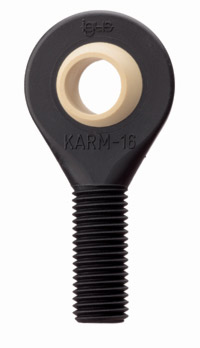
Posted to News on 28th Apr 2014, 00:00
Dependable MTTF - The Holy Grail
Dependable MTTF data is vital for engineers who need to formulate maintenance regimes and predict the working lives of machines and components. And the introduction of the Machinery Safety Directive has made the need for accurate MTTF data even more pressing. Matthew Aldridge of Igus UK explains why using plastic bearings makes this requirement much easier to satisfy.

>Mean time to failure, or MTTF, is a term that's frequently used in discussing the reliability of machines and components, but it's also a term that's often poorly understood. It is simply a statistical measure that allows the quality and durability of similar machines or components to be compared. It is useful in assessing maintenance requirements and for calculating the expected life of a component or machine but it is not, as we shall see later, a reliable predictor of how long any individual component or machine will continue to function before it breaks down.
>If only to avoid confusion, it is perhaps worth mentioning another commonly encountered term - mean time between failures or MTBF. This is a statistical measure similar to MTTF, with the key difference that MTTF is principally concerned with the time to the first failure, whereas MTBF considers multiple failures with each failure being repaired and the machine or component put back into service. Put simply, MTBF includes the time needed to repair failures (mean time to repair or MTTR), whereas MTTF doesn't.
>Clearly, since all users of machines and components are concerned with reliability, MTTF has always been an important measure. This importance is brought into even sharper focus, however, by the Machinery Safety Directive, the latest version of which, 2006/42/EC, came into force at the end of 2009. This Directive lays down essential requirements for all machines and combinations of machines that are supplied and used in Europe.
>While it is initially the responsibility of machine suppliers to ensure that the provisions of this Directive are met, it is important to note that Regulation 10 of PUWER (the Provision and Use of Work Equipment Regulations) requires that an employer must ensure that any equipment subject to European Directives complies with all applicable Essential Health and Safety Requirements (ESHRs) of the Directives that apply to it. In other words, employers also have a responsibility to ensure compliance with the Machinery Safety Directive.
>As might be expected, the provisions of this Directive are wide ranging, but in the context of this article one area of particular interest is Section 1.3, which deals with protection against mechanical hazards. Within this section, clause 1.3.2 includes the following: "The durability of the materials used must be adequate for the nature of the working environment foreseen, ... in particular as regards the phenomena of fatigue, ageing, corrosion and abrasion. The instructions must indicate the type and frequency of inspections and maintenance required for safety reasons. They must, where appropriate, indicate the parts subject to wear and the criteria for replacement."
>That's very clear - the Directive imposes obligations to predict the wear and life of components used in machines. And, of course, accurate MTTF data is the key to making these predictions. Such data is particularly important in relation to traditional bearings, as these most often fail catastrophically, giving rise to potential safety hazards. But there's a problem. As we've already said, MTTF data is based on statistical analysis and, as the name makes clear, it indicates only the mean - or average - time to failure. By the very nature of averages, this means that there will be items that fail sooner than the MTTF, some of them possibly much sooner.
>In other words, as we noted earlier, for any individual machine or component the MTTF is a poor indicator of when the next failure will occur. Nevertheless, MTTF data is the only valid way of comparing the quality and durability of conven-tional bearings. With these bearings, however, the picture is further complicated because operating life and reliability don't depend only on the quality of the bearing, but are also influenced by many external factors, such as the presence of contaminants and the level of lubrication.
>So what's to be done? Machine designers and users still, after all, need realistic maintenance regimes and they still need accurate information about the life of their machines and the components used in them. The answer, when it comes to bearings at least, is to use polymer bearings rather than conventional types. Polymer bearings can, with advantage, replace bronze, metal-backed and even ball bearings in almost any application, but why does their use make such a big difference to machine reliability and life calculations? Let's explain.
>First of all, the best of polymer bearings, such as those in the Igus iglidur range, are self-lubricating, which means that their useful life is not influenced by the provision or absence of external sources of lubrication. And because they are self-lubricating, they are unaffected by the presence of contaminants. They are also resistant to corrosion and chemical attack, and they offer a constant low coefficient of friction throughout their lives. This is a marked contrast to metal-backed bearings, for example, that often become scratched during use, leading to increased friction.
>Probably the biggest benefit of polymer bearings, however, is that they don't 'wear out' in the conventional sense, and they almost never suffer catastrophic failure. Instead, their life is determined solely by the amount of wear that is acceptable before replacement is advisable, a commonly adopted figure for plain bearings being 0.25mm. Note that even when this end-of-life condition is reached, the bearing has not failed; it is still working but with greater clearance.
>Further, with simple input data - such as load, temperature, speed and shaft material - designers can accurately calculate the life of polymer bearings. Igus offers an online calculator to perform this function, or alternatively the company will carry out the necessary calculations for customers as a free service.
>The data used as the basis for life calculations relating to polymer bearings has been determined over thousands of tests, and the results provided by the calculations are accurate and reliable, rather than being statistical estimates. In other words, when high quality polymer bearings are used, designers and machine users are freed from the problems associated with MTTF data for conventional bearings. Instead, they have attained the Holy Grail of working with real-world, end-of-life data that is truly meaningful and reliable.
>The Machinery Safety Directive and PUWER mean that reliability is a key issue for everyone who specifies, designs, supplies, works with or maintains machines. Reliability is, however, notoriously difficult to quantify accurately, but polymer bearings, with their predictable operating lives and wear characteristics, make this task much easier and much more manageable.







